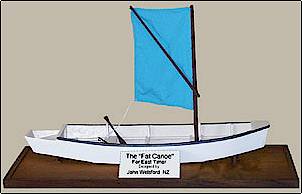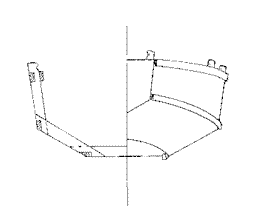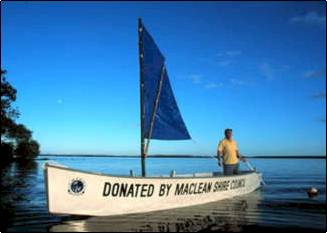I live in a country which is a solid mixture of the South Pacific and the Western European, a country where most are aware that some peoples have a preference for ways which are relevant to their traditions and ways of life. When Barry Wicks, a retired expatriate New Zealand boatbuilder ( now an Australian resident in the Northern New South Wales town of Chatsworth
Island) rang me out of the blue and told me of the group ABET (“Aussie Boats for East Timor”) and their ambition to help replace the many thousands of fishing boats destroyed by the Indonesian backed terrorist Militias, I was very keen to be involved.
 I was aware that prior to leaving this largely undeveloped tropical
country the Indonesians had ravaged the land leaving thousands dead, most of its buildings and roads destroyed, and much of its population driven off their lands. I was aware that prior to leaving this largely undeveloped tropical
country the Indonesians had ravaged the land leaving thousands dead, most of its buildings and roads destroyed, and much of its population driven off their lands.
Barry asked if I would be prepared to design a boat to suit the coastal people , one that would be cheap to build in his own area , one that could then be transported the 3000 miles to East Timor, and which would suit the locals so that the subsistence fishing villages could once again fend for themselves.
Now the obvious thought would be a plywood outboard runabout, one that would be large enough to carry two or three, stable and seaworthy, easy to build and so on. But there were a few issues. No Petrol, no mechanics, no knowledge of how to maintain the power plants, no spares and so on. A United Nations report I got my hands on told us that there were over 10 000 “canoe fishermen” now without boats who were the essential
providers for their villages, I decided to target that shortage.
Also of interest was the kind of boats that the locals were comfortable with. I asked a New Zealand Army staffer on post up there to do some research for me --Canoes, mostly outriggers carved laboriously from solid logs. Low freeboard, narrow, heavy, paddled facing forward and occasionally sailed. To inflict a high speed vee bottomed runabout on most of these people would lead to boats rotting on the foreshore while the people waded out to try and catch dinner, the difference is just too great for the villagers.
I looked first at the villagers boats, how do they paddle, when do they sail, how do they fish, what are the other uses of the boats ,
i.e., transport, freight and so on.?
Next I looked at the resources available to Barry in his semi rural town. There are a couple of plywood mills in the area, a good supply of treated lumber, rail and road shipping, major suppliers of adhesives and fastenings are with range and labour is plentiful when the sugar cane harvest is over.
Matching the two sets of criteria was not hard, once the job of researching the critical factors was done the two actually fit together surprisingly well. Considering costs and freight meant kitsetting had to be an option, and given that a two year service life for a very simple boat would give the East Timorese time to rebuild their own boats we could be really basic as long as it did the job.
|

The Fat Canoe
|
Enter the “Fat Canoe”. I looked at ways of producing a kitset that would be shippable in a 20ft container, that would make optimum use of plywood and standard sized builders yard lumber, would use simple gun applied builders adhesives and galvanised nails, plastic house paint and bamboo spars with a polytarp sail. It should ideally be assembled by the locals themselves and should not require high skills to produce a useful boat. All this and fit the canoe preference of the end users!
I took a wide bottomed Dory shape, and made her completely parallel through the middle four frames, gave her a narrow
pram bow to take most of the twist out of the sides, worked in a lot of rocker at each end and drew a motor mount for a 5hp motor ( if and when available) on the stern. Her frame heads are left high so two can be strapped together to make a catamaran that will carry close to two
tons. She has a simple sail which is a lot more effective than it looks. Ply tops on the seats form the bracing and mast steps, she has a doubled bottom for grounding and a very solid gunwale to cope with net hauling and freight.
Barry built a prototype, the cost was pretty good although the finish was much better than I had thought appropriate for the job. In fact I don’t think Barry could build a quick and dirty boat if he tried, you can take the boat builder out of the craft but you cant take the craft out of this particular boat builder.
Trial runs showed promise, two small kids could paddle the amazingly capacious boat, it sailed much better than any of us thought the silly little tarp would push her and the stability was very impressive. When Barry put a tired old outboard on it she really moved on out! It performed all of the functions I had designed for very well, was super simple to hang together and with its distinctive looks has attracted a lot of attention.
As a distant but proud member of the team (Barry and I are about 1300 miles, and the Tasman Sea apart), I have to thank the many people who have given to the project, and in particular the MacLean Shire Council who sponsored the prototype.
In early May, she was loaded up with nets, fishing lines, hooks and sinkers
(anything lead in East Timor has been long ago smelted down for bullets),
A local company shipped it up to Dili (capital of East Timor ) into the care of the UN fisheries crew, and Barry has gone up there to introduce the boat to the locals and see if we need to alter the design before we pitch into making them by the hundred and shipping kitsets off by the containerload.
I was feeling pretty happy about progress on this, when Barry rang me last Monday night with the news that He’d just had a shout from the UN man on the ground up there to say that a container with 300 odd 15hp Yamaha outboard motors had arrived! Could we produce a boat that would make good use of them, there would be enough support to keep the motors running in some of the more heavily settled areas and could I revisit the original brief. By the way could Barry take some proposal drawings with him on Thursday?????
My initial thought was that a square tailed version of the “ Fat Canoe” would be the way to go, but on doing the numbers for the shape I came to the conclusion that in light ship trim the thing would do at least 25 knots and at that speed the thing would quite likely trip over its hard chines in a sharp turn. Dangerous!
So it was back to the runabout, this is not your recreational environment , and conventional deep vee boats are not appropriate for the use. 15HP is nowhere enough if the boat is to perform, it would not carry much of a load, would be too small, unstable at rest and have a poor working floor space.
|

Trover
|
Enter TROVER, (a gatherer or collector of (treasure) trove by one old dictionary). She is longer and sharper than we see in the boat dealers, has a narrow flat power dory bottom with rocker in the forward section to help her plane, a moderate vee chine section each side, with no twist in it this chine panel runs forward of the bottom and forms a very sharp entry which is then cut off to a
pram bow transom to clip off the excess overhang.
There is a well aft to house the motor to reduce the chance of swamping when beaching in the surf, buoyancy tanks built into each side and another 200 mm deep through the forward two frame bays which gives her enough lift to support the motor and two fishermen clear of the water when swamped. I have extended some of the frame heads to provide tying off points, and left the sole flat through the centre of the boat to provide a working space.
Building this boat will be a breeze, no twist in any panel, all of the ply comes out of even dividers of the 4 ft width of the sheet so there wont be enough ply left to provide much more than kindling for the shop fire. She uses builders yard lumber for all of the frames and stringers, bevels are constant throughout so can be cut on a table saw and the frames are
simple glued and nailed overlaps. I reckon about US$300 and 40 hours would build what should be a very effective workboat. Just the ticket for laying longlines, setting a fishtrap or crab pots, setting a cast net or just taking the Mother in Law to town.

Watch this space for a report when Barry returns from East Timor.
By the way, plans for the “Fat Canoe”(now called "Clarence River Dory") are available for US $125 post paid, Trover is $90. |
![]()